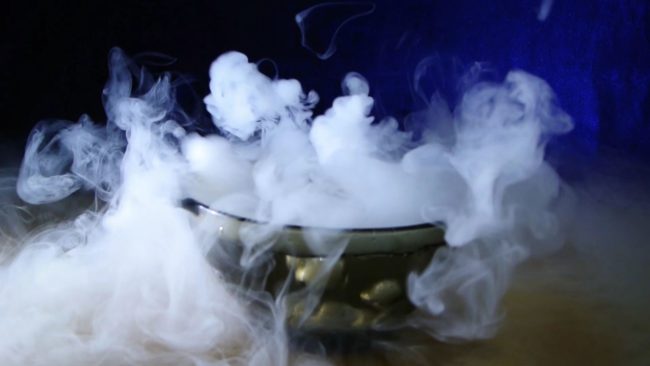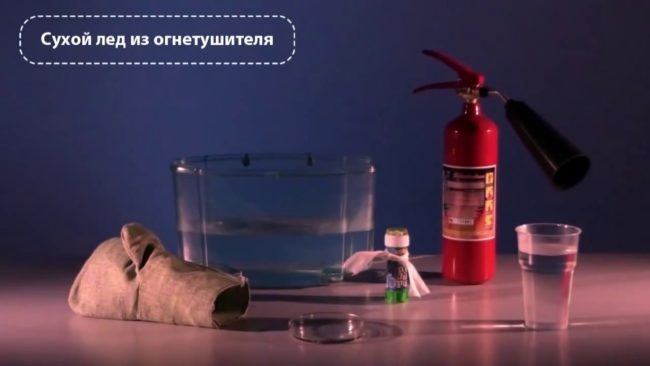The discoverer of dry ice is Charles Tilori - a chemist from France. It was he who in 1834 was the first to receive solid carbon dioxide. Industrial production of substance was established after half a century. What is this substance and how to make dry ice? How can I use dry ice? What experiments with dry ice for children can be spent at home? What rules should be observed when working with a substance? This will be discussed further.
Content
Dry ice: composition, properties
Dry ice is called carbon dioxide (carbon dioxide) in a solid state. The substance is white, does not have a pronounced smell, taste. It is used mainly for cooling. Visually resembles ice, however, at atmospheric pressure and room temperature, it does not go into liquid, but to a gaseous state (sublimate).
Dry ice: photo in different conditions


Excessive concentration of carbon dioxide in the air leads to negative consequences, therefore, solid carbon dioxide should be transported, applied and stored in well -ventilated places.

The temperature of dry ice is below 70 degrees Celsius, so the use of protective equipment in contact with the substance is mandatory. Dry ice for children is not a toy, it can only be used under the strict control of the elders.
The substance is not toxic, therefore, with proper caution, it can be used in everyday life.
Is it possible to make dry ice at home?
For the production of solid carbon dioxide on an industrial scale, pelletizers or block-maker are used-special equipment for creating dry ice.
To cover domestic needs, large volumes of substance are usually not required. To obtain a small amount of solid carbon dioxide, there is no need for special equipment, only a source of compressed carbon dioxide and improvised materials are needed.
How to make dry ice with a fire extinguisher
It will be required:
- carbon dioxide fire extinguisher (indicated by the letters of the OS), powder or foam fire extinguishers are not suitable for these purposes;
- dense gloves to protect the hands;
- glasses to protect the eyes;
- clothing that closes the arms and legs as much as possible;
- closed shoes;
- dense bag/construction glove;
- scotch.
Production of dry ice:
- Remove all jewelry from your hands, put on closed clothes and shoes, protect your hands with gloves, and eyes with glasses.
- Place the bell of the fire extinguisher in a dense bag, wrap the material around the bell, fix with tape.
- Delete a safety check.
- Launch a fire extinguisher for a few seconds. Carbon dioxide will seep through the material, therefore it is necessary to conduct experience on the street or in a well -ventilated room.
- Pull the bell of the fire extinguisher from the bag. It is recommended to keep the bag vertically.
- The formed carbon dioxide formed at the bottom of the bag is placed in a suitable container.

How to make dry ice with carbon dioxide cylinder
The way to make dry ice without a fire extinguisher differs from the method using a fire extinguisher only a source of compressed carbon dioxide.
It is important that the carbon dioxide cylinder is equipped with a submersible tube, otherwise it will not work to make dry ice.
How to store dry ice
- Dry ice turns into carbon dioxide at a temperature of –78.5 degrees Celsius. Under ordinary conditions, this process can only be slightly slowed down, but not stopped, so it is recommended to make dry ice immediately before use.
- Store the substance in well -ventilated rooms.
- For storing the substance, a separate container is required. Isothermal containers are ideal for these purposes. If there are no one in stock, then you can use the cooler bag.
- Tara made of glass, porcelain, ceramics, metal is not suitable for storing solid carbon dioxide.
- The container for storing dry ice should not be hermetically closed. The process of sublimation is accompanied by the release of a large volume of carbon dioxide, which can lead to an explosion of a hermetically closed container. To release carbon dioxide, it is recommended to make several small holes in the lid of the container with dry ice. If dry ice is stored in a thermos, then the cover of the latter should not be tightly screwed.
- To slow down the sublimation process, free space in a container with carbon dioxide should be filled with crumpled paper.
- The container for dry ice should be kept in the coldest place, but not in a refrigerator or freezer.
- It is not recommended to keep the container unclosed or often, without much need, it is not recommended to open the container cover - this accelerates sublimation.

Dry Ice: Application
- Cooling and freezing of food. Dry ice melts more slowly than ordinary ice, does not leave a puddle, prevents the reproduction of bacteria.
- Creating fog in heavy smoke generators.
- Animators conducting scientific shows with dry ice for children.
- Inkjet purification of surfaces.
- Obtaining low temperatures in research work.
- Carbonization of drinks. Dry dry ice for cocktails is preferable to homemade. You can use the drink only after the complete dissolution of solid carbon dioxide.

- Cold landing of parts.
- Preservation of flowers in floristry. The substance should not directly contact plants.
- Application in medicine and cosmetology. In the latter, dry ice for the face is used by professionals as peeling.
- Cooling of production and environment in the mine.
- The fight against mice, rats, moles. The substance is placed in holes, after which oxygen access to the monastery of pests is limited as much as possible. Carbon dioxide displaces oxygen, and the animals are suffocated.
- Creating pressure or inert environment. When heated, the substance expands hundreds of times, absorbs heat. Carbon dioxide does not support burning and heavier than air. These properties are used to create excess pressure or displace oxygen in containers.
- Ritual services. Carbon dioxide is used for transportation.
Experiments with dry ice for children
Experience with a ball and dry ice
It will be required:
- balloon;
- dry ice;
- deep pelvis with water/bathtub filled with water;
- gloves;
- glasses.
Conducting experience:
- Inside the ball, put a couple of pieces of carbon dioxide, tie a ball.
- Put a ball in a basin or bath.
- Observe the result. First, the ball will drown, become inflated, pops up and then bursts.

Creation of fog with dry ice
It will be required:
- tank with warm water;
- dry ice;
- gloves;
- glasses.
Conducting experience:
- Fill the solid carbon dioxide into a container filled with warm water.
- Observe the reaction. Water will begin to seethe, fall a dense smoke creeping on the floor. The reaction will continue until the whole substance sublimate.

Smoky bubbles from dry ice
It will be required:
- tank with warm water;
- dry ice;
- dishes detergent/liquid soap;
- gloves;
- glasses.
Conducting experience:
- Pour the solid carbon dioxide into a container filled with warm water.
- Add a detergent to the liquid.
- As a result, many bubbles filled with “smoke” will begin to form.

Dry ice
It will be required:
- large diameter bowl;
- warm water;
- dishes detergent/liquid soap/special liquid for creating soap bubbles;
- dry ice;
- a piece of fabric width a couple of centimeters and a length exceeding the diameter of the bowl;
- gloves;
- glasses.
Conducting experience:
- Pour water into a bowl.
- Pour dry ice into the water.
- To soak the fabric with a detergent or fluid for bubbles.
- Take the fabric with both hands at the opposite ends, draw along the edge of the bowl.
- As a result, a soap dome is formed, under which dense smoke will accumulate.

The sound of metal
It will be required:
- dry ice;
- metal spoon/scissors, etc.;
- gloves;
- glasses.
Conducting experience:
- Press the metal to a piece of solid carbon dioxide.
- As a result, a sound caused by microvibrations of a metal object with sublimation of solid carbon dioxide will be heard.
Sound lens from dry ice
It will be required:
- balloon;
- dry ice;
- sound source;
- gloves;
- glasses.
Conducting experience:
- Infoil the ball with carbon dioxide. To do this, you need to put a little dry ice into the ball, then tie the putz.
- Place the ball at a distance of about 30 cm from the ear. Sounds passing through the ball should intensify.

Rapid ice cream from dry ice
It will be required:
- dry ice. Do -it -yourself substance for food purposes is better not to use;
- blender and bowl/kitchen combine;
- bowl;
- pIALA;
- spoon;
- 2 cups of cream;
- 0.5 cups of sugar powder;
- cocoa powder-to taste;
- gloves;
- glasses.
Preparation:
- Grind carbon dioxide in a blender to a snow state.
- Beat the cream with powder and cocoa with a blender.
- In a deep bowl, mix the creamy mass and dry ice.
- Mix the mixture thoroughly until all pieces of ice are completely evaporated.
- Transfer ice cream to portioned bowls.
In a similar way, you can also cook ice cream from fruits and berries.

Conclusion
In the presence of carbon dioxide fire extinguisher or cylinder, dry ice at home is very simple to make. It is optimal to make a substance immediately before further use.
The use and storage of dry ice should be carried out in rooms with good air circulation, when working with the substance, it is important to protect the eyes and skin, in no case to allow the consumption of non -sublimated dry ice inside.
Homemade dry ice: how to use? For food purposes - not recommended. Methods associated with medicine and cosmetology are best left to people with certain professional skills. Otherwise, the spectrum of application is very extensive.









Comments
a couple of years ago, there was no side of metrogils from the same problem, there were no side effects ...
I’m not a fan of peeling at all, it saves from acne of metrogil, it also smoothes it ...
Great article! ...
I take the second course of the Capsules Climafite 911. The tides went very quickly. It became calmer, irritability went away and I sleep well ...
i also noticed - it is worth nervous, everything immediately affects the face. Therefore, I try to avoid conflicts and unpleasant people. Of the creams, I like Miaflow from wrinkles - smoothes not only small wrinkles ...